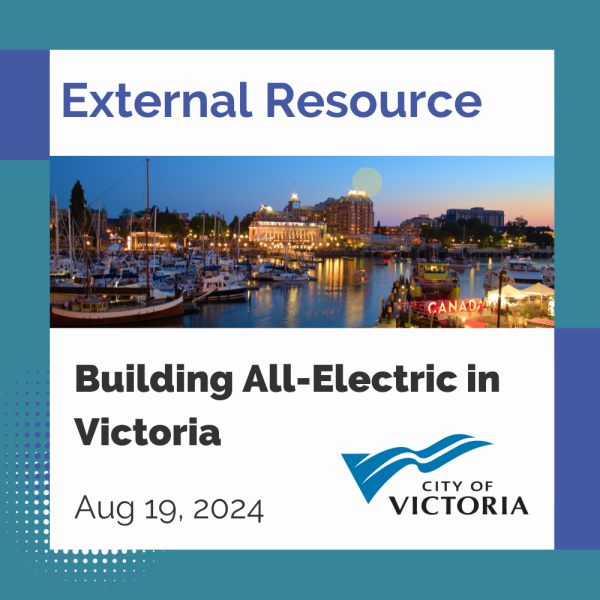
The City of Victoria is a climate leader in the Province of British Columbia (B.C). The city is committed to becoming low carbon, adopting innovative approaches to reduce greenhouse gas emissions. In 2023, Victoria became one of the first municipalities to implement B.C.’s Zero Carbon Step Code (ZCSC), requiring new buildings to minimize carbon emissions. Two reports were developed to highlight buildings that are meeting the ZCSC using electric heating systems for space and water heating. Within these reports, readers will find case study examples of real-life projects for both Part 3 and Part 9 buildings.
Key takeaways from both reports are:
1. A climate friendly building is all-electric. Burning natural gas currently makes up 42% of carbon emissions in Victoria. The highest level of the ZCSC requires all new buildings to use all-electric air and water heating systems, powered by B.C.’s low carbon electricity. By adopting the highest level, new buildings in Victoria will emit 75% fewer emissions than the average recently constructed building in the City.
2. Building all-electric is increasingly common. 25% of all large (P3) buildings built in Victoria between 2018 and 2023 already meet the highest requirement of the ZCSC, thanks to using primarily all-electric heating systems. Whether for the simplicity of design or to reduce buildings’ carbon footprint, the industry was already moving towards all-electric prior to the onset of the ZCSC. 29% of new homes built in 2020 were all-electric, and by 2023, that number grew to 53%. Many people have been opting for all-electric homes even before the ZCSC came into effect.
3. All-electric systems don’t significantly increase construction costs, but electric resistance heating can increase utility costs for tenants. Developers of these case study buildings did not view using all-electric systems as a significant cost increase compared to other project factors. Electric resistance heating for air or water can save costs while building, though it can mean higher costs for tenants. However, this approach allows building occupants to see and manage their own energy use more effectively than with centralized systems.
4. All-electric homes have similar utility costs to gas homes. Most new all-electric homes in Victoria use a heat pump and an electric hot water tank, which have similar utility costs to gas-heated homes due to the efficiency of heat pumps and avoiding monthly gas connection fees. The cost can be reduced further with the use of solar panels.
5. Embodied emissions are the next frontier in low carbon building. With all-electric systems in place, emissions associated with a building’s materials become the building’s biggest source of emissions over its lifecycle, highlighting the need for efficient design, lower carbon materials and new policies to reduce the embodied carbon of new buildings.
6. Design choices can reduce the impact of building the home. Making design choices, such as the use of simple architecture, reducing concrete, insulation and glass, using wood-frame construction and salvaging materials from the prior home, can lead to significant reductions in the emissions involved with building the home.
These case studies aim to support industry professionals through this transition by demonstrating the feasibility of meeting the requirements of the ZCSC.
Access the reports below to see how buildings within Victoria are reducing their climate impacts through electrification.
 b2e@zeic.ca
b2e@zeic.ca


